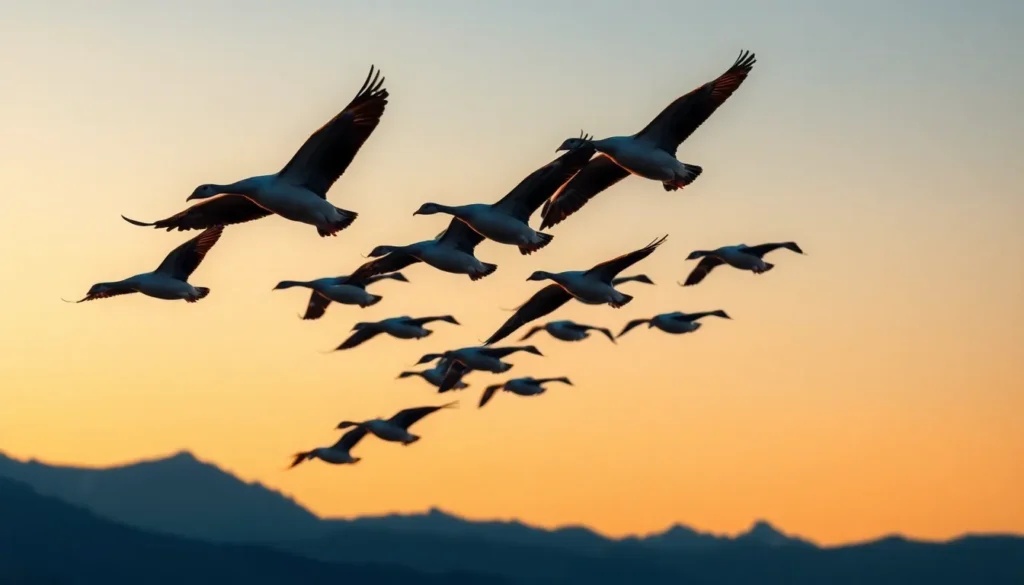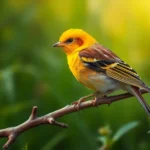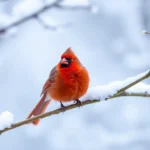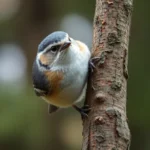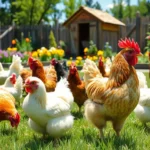Every year billions of birds embark on one of nature’s most extraordinary journeys. We’re talking about epic migrations that span thousands of miles across continents and oceans with nothing but instinct as their guide. These incredible creatures navigate using the stars sun and Earth’s magnetic field to find their way to distant breeding grounds or warmer winter havens.
We’ve all witnessed the mesmerizing sight of V-shaped flocks soaring overhead during spring and fall. But there’s so much more happening beneath the surface of these seasonal spectacles. From tiny hummingbirds crossing the Gulf of Mexico to Arctic terns completing the longest migration on Earth these feathered athletes push the limits of endurance and survival.
Understanding bird migration isn’t just fascinating—it’s crucial for conservation efforts and helps us appreciate the delicate balance of our ecosystems. Let’s explore the remarkable science behind these natural phenomena and discover why millions of birds risk everything for the journey of a lifetime.
What Is Bird Migration and Why Do Birds Migrate
Bird migration represents one of nature’s most remarkable phenomena where species travel between their breeding and non-breeding habitats following seasonal patterns. These journeys span thousands of miles and occur twice annually for most migratory species.
We observe this extraordinary behavior in approximately 40% of the industry’s 10,000 bird species. Arctic terns complete the longest migration route, traveling roughly 44,000 miles annually from Arctic breeding grounds to Antarctic feeding areas. Ruby-throated hummingbirds demonstrate incredible endurance by flying 500 miles nonstop across the Gulf of Mexico even though weighing only 3-4 grams.
Primary Drivers of Migration
Food availability serves as the most critical factor influencing bird migration patterns. Many species migrate to access abundant insect populations during breeding seasons, while others follow fruit ripening cycles or fish spawning patterns.
Breeding requirements compel birds to seek optimal nesting conditions. Temperature fluctuations affect egg incubation success rates, making timing crucial for reproductive outcomes. Daylight duration triggers hormonal changes that initiate migration instincts in many species.
Climate conditions directly impact survival rates during different seasons. Birds escape harsh winter temperatures that reduce food sources and increase energy expenditure for thermoregulation.
Types of Migration Patterns
| Migration Type | Distance Range | Examples | Frequency |
|---|---|---|---|
| Long-distance | >2,500 miles | Arctic Tern, Bar-tailed Godwit | Twice yearly |
| Short-distance | 100-500 miles | American Robin, Dark-eyed Junco | Seasonal |
| Altitudinal | Vertical movement | Mountain Quail, Rosy-finned Finch | Weather-dependent |
| Irruptive | Irregular patterns | Snowy Owl, Pine Siskin | Resource-driven |
Obligate migrants must travel between habitats to survive, while facultative migrants move only when environmental conditions become unfavorable. Partial migrants include populations where only certain age groups or sexes migrate regularly.
Evolutionary Advantages
Migration evolved as an adaptive strategy maximizing reproductive success and survival rates. Species that migrate access seasonal resource abundance unavailable to year-round residents. These travelers avoid competition with permanent populations and exploit temporary ecological niches.
Genetic studies reveal that migratory behavior passes through generations via inherited programming. Young birds learn exact routes through social learning during their first migration with experienced adults. This knowledge transfer ensures species maintain successful migration traditions across centuries.
Types of Bird Migration Patterns
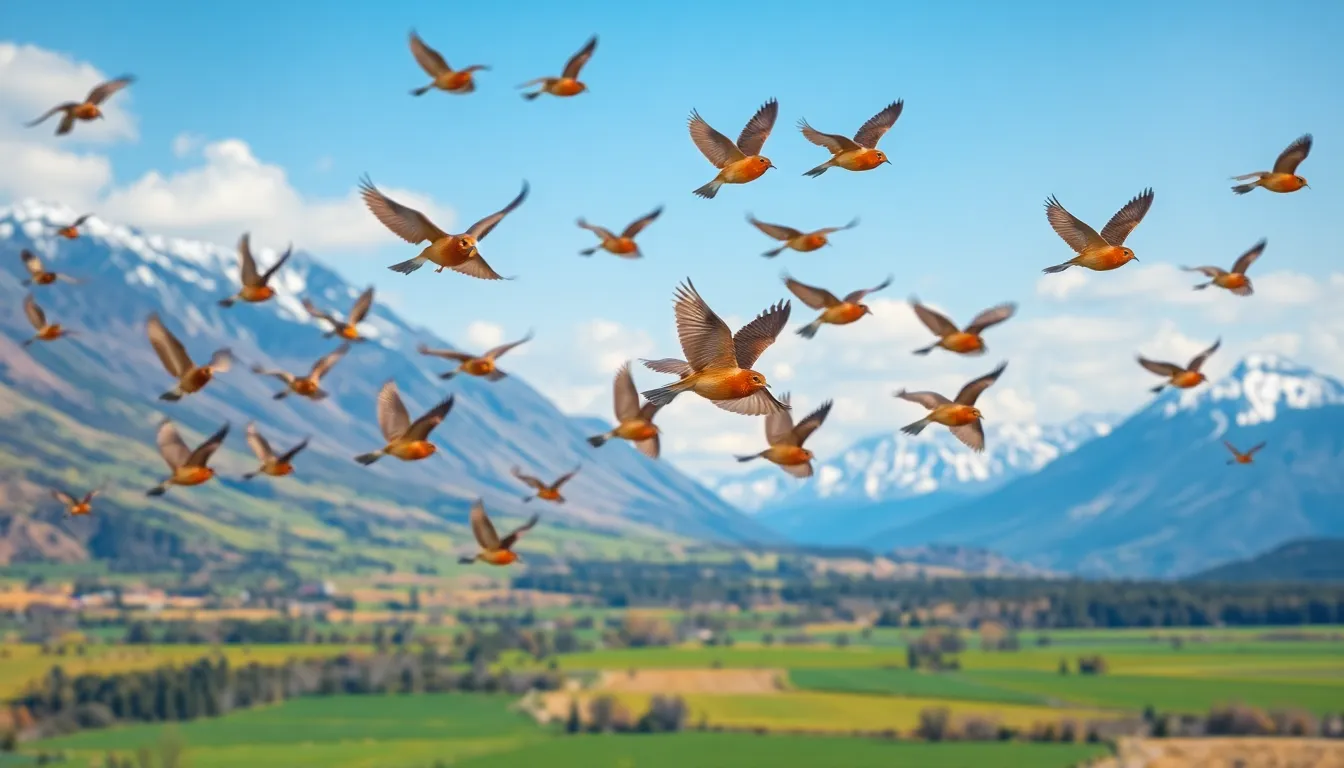
Bird migration patterns vary significantly based on environmental factors and species-exact requirements. We observe distinct categories that demonstrate how different species adapt their movement strategies to optimize survival and reproduction.
Seasonal Migration
Seasonal migration represents the most common bird migration pattern, involving predictable movements between breeding and wintering grounds. We see this pattern in approximately 1,800 North American bird species that travel between summer breeding territories and winter refuges.
Complete migrants abandon their breeding ranges entirely during winter months. Arctic terns exemplify this behavior by flying from Arctic breeding grounds to Antarctic wintering areas, covering roughly 44,000 miles annually. Bobolinks demonstrate similar complete migration by traveling from Canadian prairies to South American grasslands.
Partial migrants include populations where only some individuals migrate while others remain year-round residents. American robins showcase this pattern, with northern populations migrating south while southern populations stay put. Weather conditions and food availability determine which individuals migrate within these species.
Differential migration occurs when different demographic groups within the same species exhibit varying migration distances and timing. Female dark-eyed juncos typically migrate farther than males, with age and social status influencing migration decisions across many songbird species.
Altitudinal Migration
Altitudinal migration involves vertical movements between different elevations rather than latitudinal travel across continents. We find this pattern particularly common in mountainous regions where birds exploit seasonal resource availability at various altitudes.
Mountain species like white-tailed ptarmigan descend from alpine tundra to lower treeline elevations during harsh winter conditions. These vertical migrations typically span 1,000 to 3,000 feet in elevation change, allowing birds to access milder temperatures and increased food sources.
Seasonal altitudinal patterns follow predictable schedules with upslope movements during spring breeding seasons and downslope travel before winter. Rosy-crowned kinglets breed in high-elevation coniferous forests then move to lower mixed woodlands for winter survival.
Weather-driven altitudinal shifts occur when temporary storms or temperature extremes force immediate elevation changes. Mountain bluebirds respond to sudden snowstorms by dropping several hundred feet in elevation until conditions improve at higher altitudes.
Nomadic Migration
Nomadic migration patterns lack fixed seasonal timing or consistent destinations, driven primarily by unpredictable resource availability. We observe this strategy among species inhabiting environments with irregular food supplies or extreme climate variability.
Irruptive nomadism characterizes species that experience population explosions followed by mass dispersal movements. Snowy owls demonstrate classic irruptive behavior by moving south in large numbers during years when Arctic lemming populations crash, creating food shortages in their typical range.
Resource-tracking nomadism involves continuous movement following ephemeral food sources across vast landscapes. Brambling populations in Europe track beech mast production, with flocks moving hundreds of miles between forests based on seed availability. Pine siskins similarly follow conifer cone crops throughout western North America.
Opportunistic nomadism describes irregular movements responding to immediate environmental opportunities. Pinyon jays exemplify this pattern by traveling extensively throughout the Great Basin region, concentrating wherever pinyon pine nuts become abundant during productive years.
How Birds Navigate During Migration
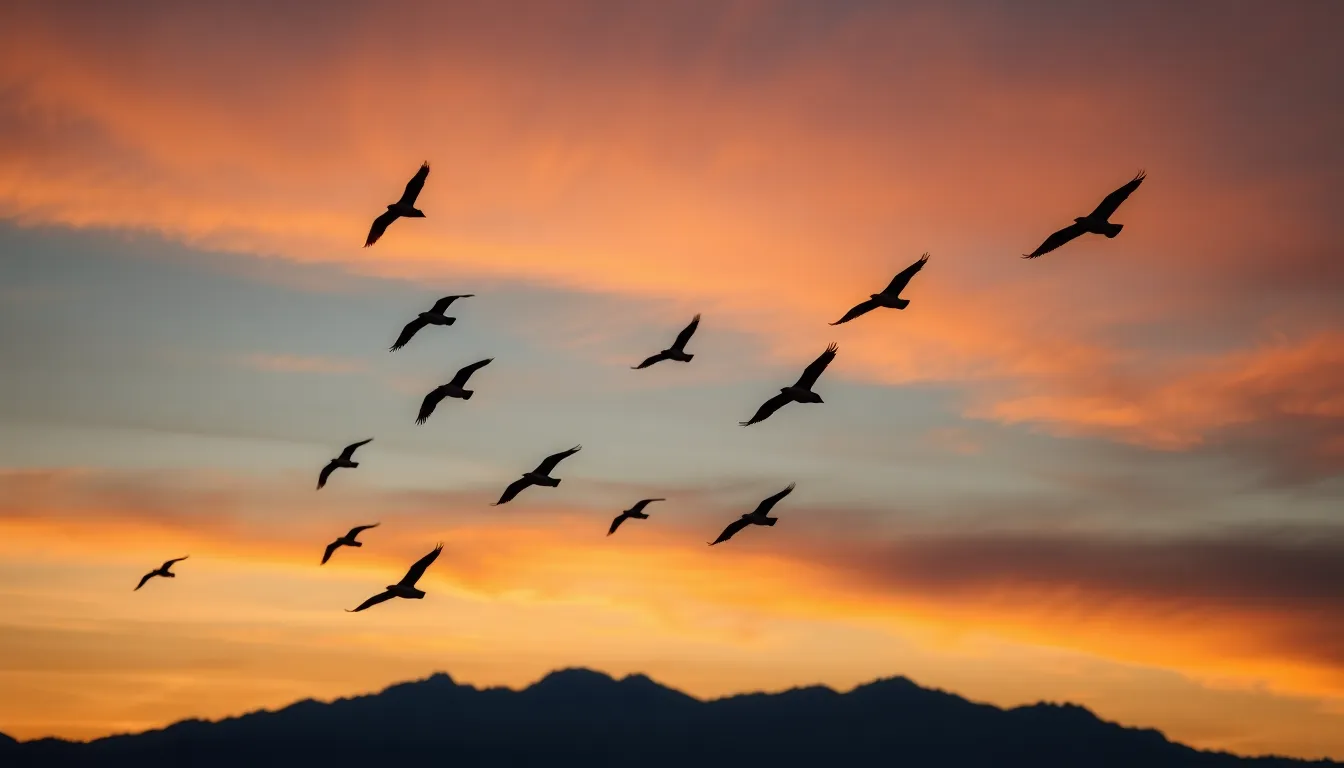
Birds employ sophisticated navigation systems that combine multiple sensory mechanisms to maintain accurate flight paths across thousands of miles. These remarkable creatures integrate magnetic field detection, celestial positioning, and landmark recognition to achieve navigation precision that surpasses human capabilities.
Magnetic Field Navigation
Magnetic field navigation forms the primary compass system for migratory birds during their long-distance journeys. Birds detect Earth’s magnetic field through specialized cells called magnetoreceptors located in their beaks, eyes, and inner ears. These magnetoreceptors contain magnetite crystals that function as biological compasses, allowing species like European robins and red-backed shrikes to sense magnetic inclination angles.
Research demonstrates that birds perceive magnetic fields through cryptochrome proteins in their retinas, creating visual magnetic maps that overlay their normal vision. Disruption studies show that radio frequency interference affects magnetic navigation in 20 different migratory species, including savannah sparrows and Eurasian blackcaps. Young birds develop magnetic compass calibration through exposure to local magnetic signatures during their first migration season.
The magnetic navigation system operates most effectively during twilight hours when light conditions optimize cryptochrome protein activation. Scientists have documented magnetic field strength variations that birds use to determine their geographic position, with sensitivity levels detecting changes as small as 50 nanoteslas in field intensity.
Celestial Navigation
Celestial navigation provides birds with accurate directional guidance using sun positions, star patterns, and polarized light cues. Diurnal migrants like white-crowned sparrows use sun compass navigation, adjusting their internal clocks to compensate for the sun’s movement throughout the day. These birds maintain directional accuracy by calculating solar azimuth angles relative to their intended flight paths.
Nocturnal migrants rely on stellar navigation patterns, with indigo buntings and garden warblers using circumpolar constellations as reference points. Planetarium experiments reveal that birds learn star patterns during their juvenile development, creating internal star maps that remain consistent throughout their lifespans. Cloud cover reduces celestial navigation effectiveness, causing 15% accuracy decreases in flight direction consistency.
Polarized light detection enables birds to navigate during overcast conditions when direct celestial cues aren’t visible. Specialized photoreceptors in bird eyes detect polarization patterns in skylight, creating navigation references even through dense cloud layers. Studies show that birds can detect polarization angles with 2-degree precision accuracy.
Landmark Recognition
Landmark recognition allows birds to create detailed mental maps of geographic features along their migration routes. Coastal migrants like sanderlings and dunlin use shoreline configurations, river systems, and mountain ranges as navigation checkpoints. These visual landmarks become increasingly important as birds approach their final destinations.
Experienced migrants develop comprehensive landmark libraries containing thousands of geographic features, including human-made structures like bridges and buildings. GPS tracking studies of barn swallows show 95% route consistency between migration seasons, indicating strong landmark memory retention. Young birds acquire landmark recognition skills by following experienced adults during their first migration journeys.
Topographic features provide hierarchical navigation references, with major landmarks like the Great Lakes serving as primary waypoints and smaller features offering fine-scale positioning. Weather conditions affect landmark visibility, causing birds to rely more heavily on alternative navigation methods during storms or fog. Research indicates that landmark recognition accuracy decreases beyond 50 miles from familiar territories.
Major Bird Migration Routes Around the World
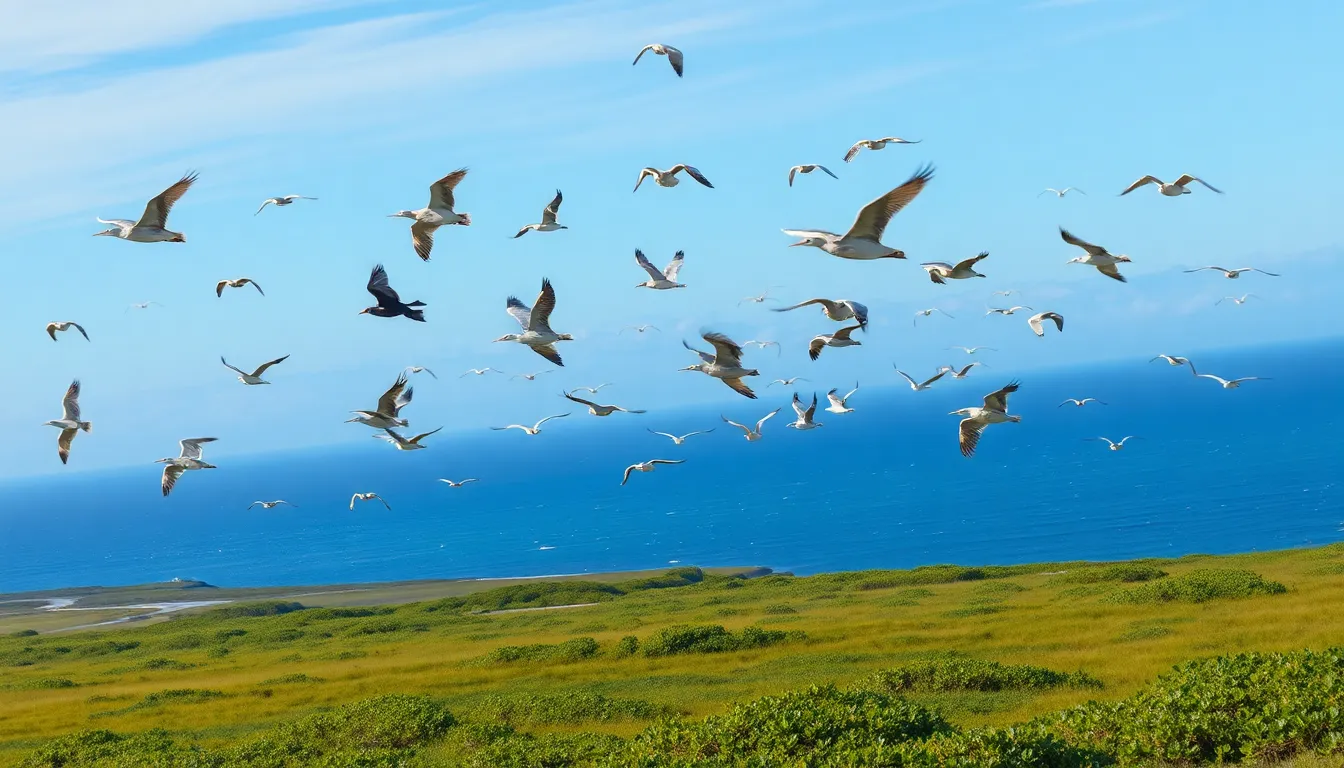
Four primary migration corridors in North America channel billions of birds between their breeding and wintering grounds each year. These flyways represent critical pathways that connect diverse ecosystems across the continent.
Atlantic Flyway
The Atlantic Flyway stretches along the eastern coastline from Arctic Canada to South America, serving approximately 500 bird species during their seasonal journeys. Coastal marshes, barrier islands, and estuarine systems provide essential stopover sites where migrants rest and refuel. Delaware Bay stands out as one of the most important staging areas, where millions of shorebirds including red knots and ruddy turnstones synchronize their arrival with horseshoe crab spawning events.
Major migration periods occur from March through May and August through October, with peak activity concentrated in September. Warblers, thrushes, and raptors funnel through concentrated corridors like Cape May, New Jersey, where researchers document over 200 species annually. The flyway connects breeding grounds in boreal forests with tropical wintering areas in Central and South America.
Pacific Flyway
Western migration routes cover the Pacific Flyway, extending from Alaska to Patagonia and supporting over 1 billion birds representing 350+ species. California’s Central Valley provides crucial habitat for waterfowl, with Sacramento and San Joaquin valleys hosting 60% of all Pacific Flyway waterfowl during winter months. Shorebird populations concentrate at key sites including San Francisco Bay, Mono Lake, and the Salton Sea.
Coastal mountains create natural funneling effects that concentrate migrants along exact corridors. Point Reyes, California records over 490 bird species, making it one of the most diverse birding locations in North America. The flyway supports iconic species including sandhill cranes, which gather in groups exceeding 500,000 individuals at staging areas.
Central Flyway
Interior migration pathways define the Central Flyway, spanning from northern Canada through the Great Plains to Mexico and beyond. Prairie potholes across North Dakota, South Dakota, and Minnesota serve as primary breeding habitat for North American waterfowl. An estimated 50% of continental duck populations use these wetland systems during breeding season.
Wind patterns and topographic features channel migrants through narrow corridors, particularly along river valleys and mountain passes. The Platte River in Nebraska hosts spectacular concentrations of sandhill cranes, with 80% of the industry’s population staging there during spring migration. Grassland species including bobolinks and dickcissels rely heavily on this flyway for their transcontinental journeys.
Mississippi Flyway
North America’s most heavily traveled migration route follows the Mississippi River system, accommodating 40% of all waterfowl and shorebirds on the continent. The river corridor provides a natural highway with abundant food resources and suitable habitat extending across 2,300 miles. Over 325 bird species depend on this flyway, including 40% of all waterfowl species.
Peak migration occurs during October and November when millions of birds move southward, creating some of the continent’s most impressive birding spectacles. Louisiana’s coastal marshes serve as the final staging area before many species cross the Gulf of Mexico. Bottomland hardwood forests along the river provide critical stopover habitat for neotropical migrants including 37 warbler species.
Factors That Influence Bird Migration
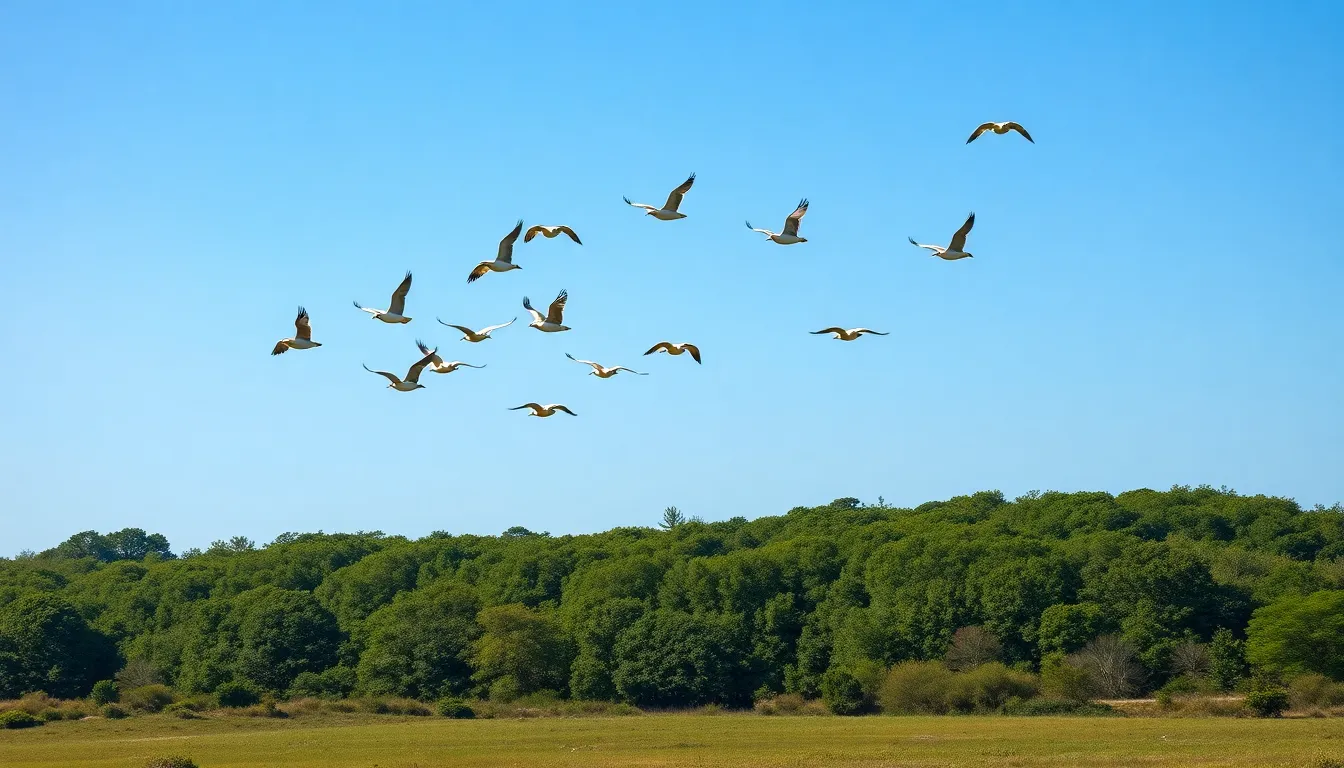
Bird migration patterns result from complex interactions between environmental and biological forces. These driving factors determine when species depart, their chosen routes, and destination timing.
Climate and Weather Patterns
Temperature variations trigger migration timing for most bird species across different regions. Arctic-breeding shorebirds like red knots initiate southward journeys when temperatures drop below 32°F in their breeding grounds. Weather systems create favorable or challenging conditions during active migration periods.
Wind patterns significantly affect flight efficiency and route selection for migrating birds. Tailwinds can increase flight speeds by 15-25 mph while reducing energy expenditure by up to 20%. Storm systems force route deviations and can delay migration timing by several days or weeks.
Seasonal precipitation levels influence insect abundance and seed production in stopover habitats. Drought conditions reduce food availability by 40-60% in critical refueling areas like the Sahel region of Africa. Climate change has shifted migration timing by 1-2 weeks earlier for many North American species over the past three decades.
Food Availability
Insect emergence patterns drive migration timing for insectivorous species throughout their ranges. Warblers time their spring arrival to coincide with peak caterpillar abundance when populations reach 200-300 larvae per tree. Fruit ripening schedules determine movement patterns for frugivorous birds in tropical and temperate regions.
Seasonal resource abundance creates predictable food corridors along major flyways. Delaware Bay horseshoe crab spawning provides 9 billion eggs annually for red knots during their northward migration. Nectar production cycles influence hummingbird migration timing with peak flowering occurring 2-3 weeks before arrival.
Marine productivity fluctuations affect seabird migration distances and destination selection. El Niño events reduce fish populations by 70-80% in the eastern Pacific, forcing seabirds to extend migrations by 500-1000 additional miles. Agricultural practices create new food sources that can alter traditional migration routes and timing.
Breeding Requirements
Photoperiod changes trigger hormonal responses that initiate migration behavior in breeding birds. Increasing daylight hours stimulate reproductive hormone production 4-6 weeks before departure from wintering grounds. Breeding habitat quality determines destination selection for species requiring exact nesting conditions.
Territory availability influences migration timing and competitive dynamics at breeding destinations. Early-arriving males secure the highest quality territories with 30-40% higher reproductive success rates. Nest site requirements limit breeding ranges for cavity-nesting species like wood ducks to areas with suitable tree densities.
Mate selection processes drive migration timing coordination between sexes in monogamous species. Sandhill cranes arrive at breeding grounds within 1-2 days of their partners from previous seasons. Breeding synchronization maximizes reproductive success by aligning egg laying with optimal environmental conditions and food availability.
Challenges Birds Face During Migration
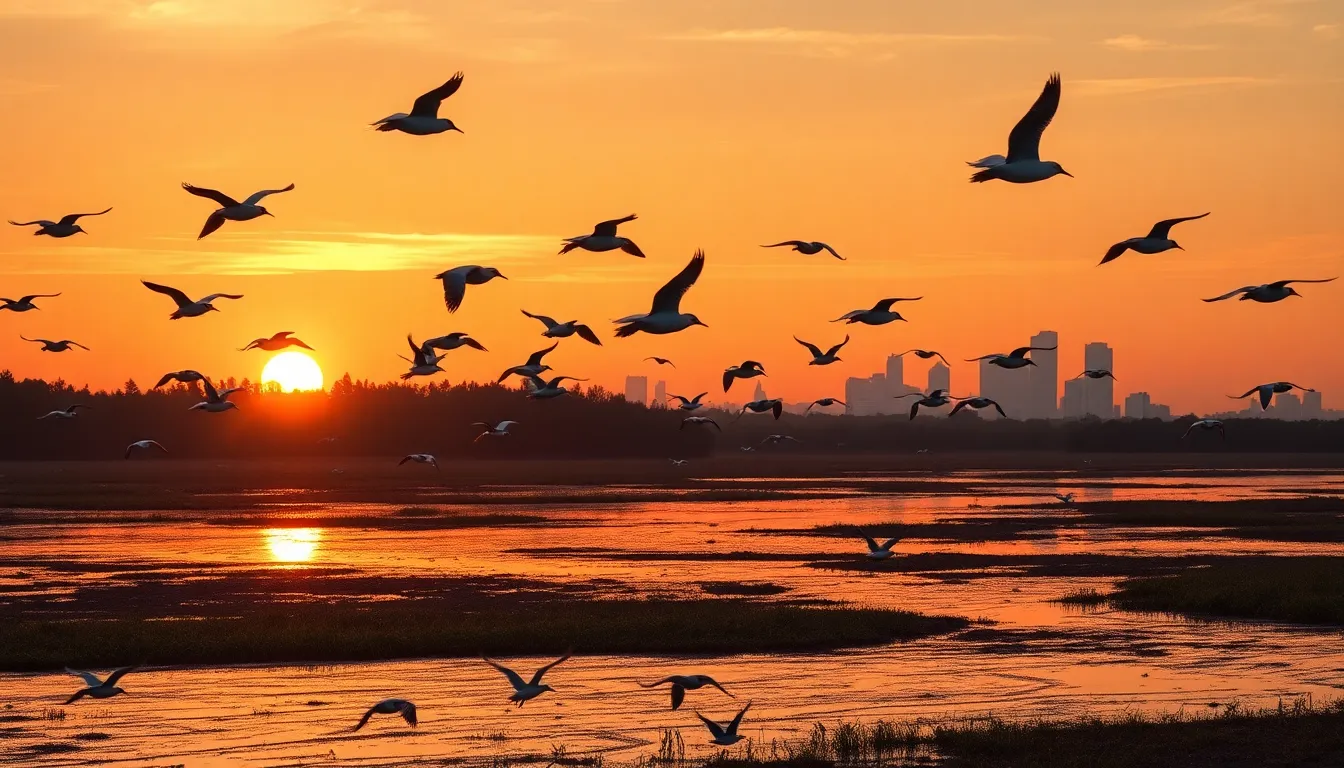
Migration routes that once provided safe passage for billions of birds now present unprecedented obstacles. Modern environmental changes and human activities create barriers that threaten the survival of countless migratory species.
Habitat Loss and Fragmentation
Wetland destruction eliminates 70% of critical stopover sites that migrating waterfowl depend on for rest and refueling. Agricultural expansion transforms natural grasslands into monoculture farms, removing the diverse plant communities that produce seeds and insects essential for songbird nutrition during long-distance flights.
Urban sprawl fragments continuous forest corridors into isolated patches, forcing birds to expend additional energy crossing unsuitable terrain. Coastal development destroys beach nesting areas where shorebirds like piping plovers and least terns traditionally breed and rest during migration.
Deforestation in tropical wintering grounds removes 15 million acres annually, eliminating the habitat that supports over 200 North American bird species during their non-breeding seasons. Forest fragmentation creates edge effects that increase predation rates and reduce reproductive success for species requiring interior forest conditions.
Climate Change Impacts
Temperature shifts alter the timing of insect emergence by 2-3 weeks, creating mismatches between peak food availability and bird arrival times. Warmer spring temperatures cause birds to arrive at breeding grounds before sufficient food resources become available, reducing survival rates among juveniles.
Changing precipitation patterns affect wetland water levels, reducing the aquatic invertebrates that fuel shorebird migrations across flyways. Extreme weather events like hurricanes and severe storms increase in frequency, destroying nesting sites and disrupting established migration timing.
Ocean temperature changes influence fish populations that seabirds depend on during migration, forcing species like Arctic terns to alter traditional feeding strategies. Rising sea levels inundate coastal marshes where many species stage during migration, eliminating thousands of acres of critical habitat.
Shifting wind patterns disrupt the atmospheric conditions that birds use for efficient long-distance flight, increasing energy expenditure and mortality rates during ocean crossings.
Human Made Obstacles
Communication towers kill 4-5 million birds annually through collisions, with mortality rates highest during nighttime migration when birds become disoriented by artificial lighting. Wind turbines present collision risks for raptors and bats, though modern turbine designs reduce bird fatalities by 20-30% compared to older models.
Glass building facades cause 365-988 million bird deaths yearly in North America alone, as migrants mistake reflective surfaces for open sky or vegetation. Light pollution disrupts natural navigation systems, causing nocturnal migrants to circle illuminated structures until they become exhausted.
Power lines create electrocution hazards for large birds like eagles and cranes, while also presenting collision risks during low-visibility conditions. Vehicle strikes along highways crossing migration corridors kill millions of birds annually, particularly ground-dwelling species like mourning doves and northern bobwhites.
Pesticide applications eliminate insect prey populations and contaminate water sources along migration routes, reducing food availability and causing direct toxicity in many species. Domestic and feral cats kill 1.3-4 billion birds annually in the United States, with impacts concentrated around urban and suburban areas where migrants seek refuge.
Conservation Efforts for Migrating Birds

Conservation efforts for migrating birds focus on protecting critical habitats and establishing collaborative frameworks that span international boundaries. These initiatives address the complex challenges facing billions of migratory birds by creating safe passages and coordinated protection strategies.
Protected Migration Corridors
Protected migration corridors establish secure pathways along the four major North American flyways, covering approximately 2.3 million square kilometers of critical habitat. The Western Hemisphere Shorebird Reserve Network designates 107 sites across 17 countries, protecting essential stopover locations like Delaware Bay’s horseshoe crab spawning beaches where red knots refuel during migration.
Federal Protection Systems
- National Wildlife Refuge System maintains 568 refuges covering 150 million acres along migration routes
- Waterfowl Production Areas protect 3.5 million acres of prairie pothole breeding habitats
- National Park Service preserves 85 million acres of migratory bird habitats across 419 sites
- Bureau of Land Management oversees 245 million acres supporting diverse migratory species
State Conservation Networks
State wildlife management areas contribute 45 million acres of protected migration habitat, with Texas leading at 8.2 million acres followed by Alaska’s 5.4 million acres. Important Bird Areas program identifies 2,400 critical sites across North America, encompassing wetlands, forests, and grasslands essential for migration success.
Private Land Conservation
Private landowners protect 76% of wildlife habitat in the United States through conservation easements and voluntary agreements. Partners for Wildlife program enrolls 58,000 landowners annually, restoring 230,000 acres of migration habitat each year through grassland restoration and wetland enhancement projects.
International Cooperation Programs
International cooperation programs coordinate bird migration conservation across 44 countries through multilateral treaties and bilateral agreements. The Migratory Bird Treaty Act of 1918 established the foundation for protecting 1,026 bird species that migrate between the United States, Canada, Mexico, Japan, and Russia.
Multinational Conservation Initiatives
| Program | Coverage | Species Protected | Annual Funding |
|---|---|---|---|
| Partners in Flight | Western Hemisphere | 448 landbird species | $89 million |
| North American Bird Conservation Initiative | North America | 1,154 species | $156 million |
| Western Hemisphere Shorebird Reserve Network | Americas | 81 shorebird species | $12 million |
| East Asian Australasian Flyway Partnership | Asia Pacific | 250 waterbird species | $8.5 million |
Bilateral Conservation Agreements
Mexico and United States collaborate through the Trilateral Committee for Wildlife and Network Conservation, investing $67 million annually in shared migration habitat protection. Canada and United States maintain the Migratory Birds Convention Act, allocating $124 million yearly for joint conservation projects along the Arctic breeding grounds.
International Monitoring Systems
eBird database collects 100 million bird observations annually from 700,000 contributors across 240 countries, providing real time migration data for conservation planning. Motus Wildlife Tracking System operates 1,500 automated radio telemetry stations throughout the Americas, monitoring individual bird movements across international boundaries.
Community-Based Conservation
Community based conservation engages 2.8 million volunteers annually in bird migration monitoring and habitat restoration projects across North America. Christmas Bird Count mobilizes 81,000 participants each December, generating population data for 2,600 species across 2,400 count circles.
Citizen Science Programs
- Breeding Bird Survey employs 3,000 volunteers covering 4,100 survey routes annually
- Great Backyard Bird Count attracts 385,000 participants from 192 countries each February
- Migration monitoring stations operate at 260 locations with 15,000 volunteer hours logged yearly
- Journey North engages 60,000 students tracking migration patterns in real time
Local Conservation Groups
Audubon chapters operate 460 local conservation programs protecting migration habitats through land acquisition and restoration efforts. These chapters manage 100,000 acres of bird sanctuaries and conduct educational programs reaching 500,000 people annually about migration conservation needs.
Corporate Conservation Partnerships
Bird Friendly Coffee certification protects 285,000 acres of wintering habitat for Neotropical migrants through sustainable farming practices. Wind energy companies invest $73 million yearly in migration research and habitat offset programs, reducing turbine related bird mortality by 35% through improved siting and operational modifications.
Indigenous Community Involvement
Native American tribes protect 56 million acres of traditional lands that serve as critical migration corridors, incorporating traditional ecological knowledge with modern conservation science. First Nations communities in Canada manage 630 million acres of boreal forest breeding habitat through sustainable land use practices and collaborative monitoring programs.
Conclusion
The remarkable journey of migratory birds represents one of nature’s most awe-inspiring phenomena. As we’ve explored throughout this comprehensive guide these extraordinary travelers demonstrate incredible resilience and adaptability in their annual voyages.
Our understanding of bird migration continues to evolve as researchers uncover new insights into their navigation abilities and behavioral patterns. Each discovery reinforces how crucial these species are to maintaining healthy ecosystems worldwide.
The future of bird migration depends on our collective commitment to conservation. By supporting habitat protection initiatives and staying informed about migration challenges we can help ensure these magnificent journeys continue for generations to come.
Whether you’re a seasoned birdwatcher or simply curious about nature bird migration offers endless opportunities for wonder and discovery right outside our doorsteps.
Frequently Asked Questions
What is bird migration and how common is it?
Bird migration is a natural phenomenon where species travel between breeding and non-breeding habitats following seasonal patterns. Approximately 40% of the world’s 10,000 bird species participate in migration, with billions of birds undertaking these incredible journeys annually across vast distances to reach their breeding and wintering grounds.
How do birds navigate during their long migrations?
Birds use sophisticated navigation systems combining multiple sensory mechanisms. They rely on magnetic field detection through specialized cells called magnetoreceptors, celestial navigation using sun positions and star patterns, and landmark recognition to create mental maps of geographic features along their migration routes.
What are the main types of bird migration patterns?
The main migration patterns include seasonal migration (the most common type), altitudinal migration (vertical movements in mountainous regions), and nomadic migration (unpredictable movements based on resource availability). Birds can be classified as complete migrants, partial migrants, or irruptive migrants depending on their specific migration behavior.
What drives birds to migrate?
Primary drivers of bird migration include food availability, breeding requirements, temperature fluctuations, and climate conditions. Birds migrate to access seasonal resources, avoid harsh weather conditions, find optimal breeding habitats, and reduce competition for food and nesting sites in their year-round territories.
What are the major migration routes in North America?
North America has four primary migration corridors: the Atlantic Flyway (along the eastern coastline), Pacific Flyway (from Alaska to Patagonia), Central Flyway (through the Great Plains), and Mississippi Flyway (following the river system). These flyways collectively support billions of migrating birds and connect diverse ecosystems.
What challenges do migrating birds face today?
Modern challenges include habitat loss and fragmentation from urban development, climate change impacts that disrupt food timing, human-made obstacles like communication towers and glass buildings, vehicle strikes, and wetland destruction. These threats create unprecedented obstacles that increase mortality rates during migration.
How are conservation efforts helping protect migrating birds?
Conservation efforts include establishing protected migration corridors covering 2.3 million square kilometers, creating wildlife refuges, implementing the Important Bird Areas program, engaging in international cooperation, and involving local communities in habitat restoration. Private land conservation and corporate partnerships also play crucial roles.
How do young birds learn migration routes?
Young birds learn migration routes through social interactions with experienced adults. They inherit migratory behavior genetically and develop navigation skills by following adults on their first migrations. This process ensures the continuation of successful migration traditions across generations and helps birds build comprehensive landmark libraries.

